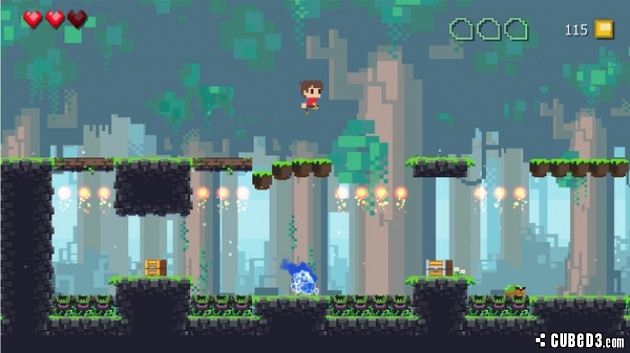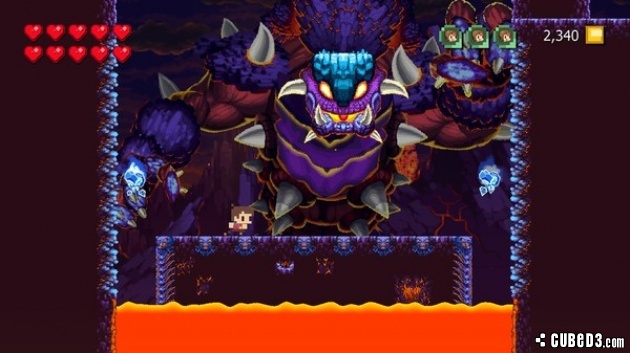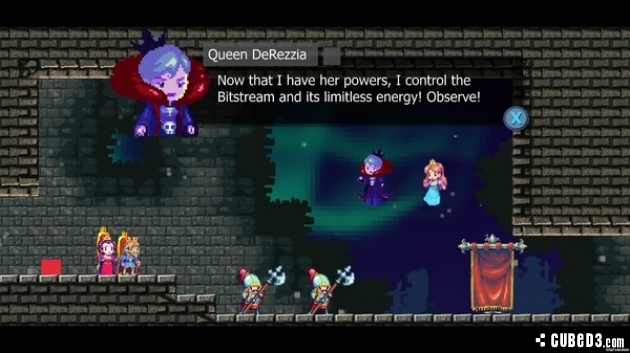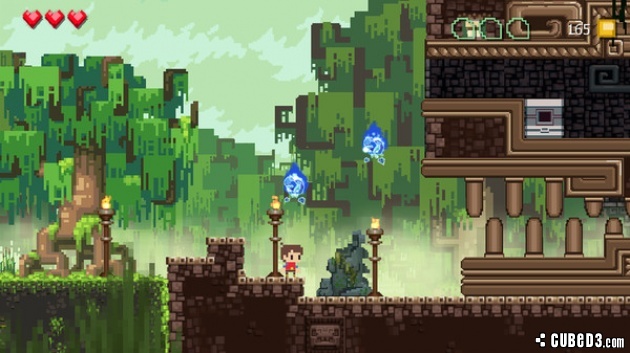Adventures of Pip (PC) Review
By Jordan Hurst  02.08.2015
02.08.2015

The phrase "pleasant surprise" is likely to pop up anywhere Adventures of Pip is being discussed, and it's even more appropriate here than for most titles it's applied to. "Pleasant" is the best way to describe practically every aspect of the game. It's a straightforward, solidly built platformer erected in a functional middle ground between puzzle and action, featuring a simple, attractive aesthetic. It won't change anyone's life, but for those whose childhoods were dominated by the 2D platformer, it will remind them why. After a glowing hands-on, Cubed3 now takes the final version for a spin.
Adventures of Pip takes place in the most typical game setting possible - a medieval-era kingdom separated into areas such as a forest, a swamp, and a volcano - with one important difference: pixels act as both currency and biological composition. As a result, the kingdom's social hierarchy is based entirely on its citizens' visual resolution. The plot begins with the kingdom's princess being kidnapped by the villainous Queen DeRezzia, who uses the princess' special connection to the Bitstream (the world's source of pixels) to wreak resolution-related havoc. Don't think too much about this premise; it's decidedly silly. It does, however, allow for the game's brilliant core mechanic: when Pip the protagonist, born as a single pixel, comes into contact with the Bitstream, he gains the ability to cycle through different graphical versions of his body, each with unique characteristics.
The mechanic is brilliant for several reasons. Chiefly, each form is equally useful. The tiny single-pixel form can squeeze into small gaps and float to safety, the speedy 8-bit form is able to cling to and jump off walls, and the lumbering 16-bit version can destroy barriers and move blocks. In addition to these unique abilities, the forms are notable for their different weights, a property that affects at least half a dozen things throughout. It also sees equal use across all of Pip's incarnations, even when such a thing seems unlikely. For example, 16-bit form's inability to bounce on springs due to simply crushing them with his footsteps seems like a pure weakness…until Pip encounters a path of springs that will launch his simpler forms right into a ceiling of spikes.

Gameplay is almost entirely driven by the interplay of the three forms. Switching between them, often in mid-jump, is crucial for navigating the game's cleverly constructed levels. In fact, figuring out how to traverse an area is just as important as actually traversing it. Thus, developer TicToc Games has solved the problem of how to create a puzzle-platformer with a decent pace: none of the "puzzles" are overly difficult, but they force the player to approach each obstacle analytically, preventing brute force tactics. Interestingly, there is only manual control over the transformations when reverting to simpler ones, while upgrading requires destruction of specific enemies. It seems an odd choice at first, but it affords the developer great control over a gamer's options, allowing for tightly designed levels and a stable difficulty curve.
Adventures of Pip's difficulty level is undoubtedly one of the biggest reasons it is so much better than expected. Everything begins quite simply, but gradually ramps up the complexity and required precision of its obstacles - so gradually, in fact, that most won't even realise the difference until later on, at which point the team starts pulling out all the stops regarding what Pip's abilities can accomplish, and the generous checkpoint system becomes a necessity, allowing for quick, close respawns that eliminate as much frustration as possible. The game is also adept at teaching its mechanics through gameplay, specifically in situations where there is a requirement to use an ability in such a way that it inadvertently demonstrates the action's secondary traits.

Finally, Pip's different forms provide vital contrast to the experience. Similar titles would likely divide themselves into three segments, each introducing and focusing on a new form and linearly progressing through them. Adventures of Pip, on the other hand, has all three forms introduced within the first hour, and spends the rest of its time effectively juggling them, preventing people from ever growing complacent and, by extension, bored. The fact that the player can be easily restricted to the single-pixel form by withholding upgrade-dropping enemies is used to great effect. While this form is often useful, it's still the most defenceless, as the others can attack with fists and swords. This further fights instincts toward complacency, since at any point the lead can be reduced to a vulnerable dot in a claustrophobic tunnel.
Adventures of Pip would be better if it dedicated itself completely to its gameplay, and for the first couple of hours, it seems like that's going to be the case. However, instead, it begins to introduce potentially subversive plot threads that go absolutely nowhere. There are bona fide twists in the story that would have been unexpectedly awesome…except that they are completely inconsequential. They also have the irritatingly shallow postmodern tendency of having characters announce when they are delivering a twist. Most bizarrely, the game actually toys with the implications of its resolution-based society, including the word "rez-ist" in dialogue and questioning the motive behind Pip defending the kingdom that considers him a second-class citizen. The thought is ignored immediately, though, and Pip's status as a silent protagonist leaves the question as an uncomfortable loose end.

It's indicative of how skillfully designed and executed the gameplay in Adventures of Pip is that the game is not utterly forgettable, as it feels like it should be. In addition to the most ordinary setting imaginable, most of the obstacles are standard 2D platformer fare. Heavy wind, rising lava, and creatures that ferry Pip across hazardous terrain all make appearances, among other things. The body-upgrading technique certainly puts its own spin on some of them, but whether that refreshes them enough is debatable. Additionally, aside from acquiring pixels to pay for largely trivial upgrades, the only side activity available is rescuing the villagers strewn throughout each level. They are slyly yet fairly hidden, but it feels as though an opportunity was missed to have the village be more than just a gallery of those that have been rescued.
While the inoffensive design may not be particularly groundbreaking, the enjoyable results are inarguable. The smooth controls are a godsend; the later levels would be a nightmare if Pip's jumping abilities were any less flexible. Every aspect has been made as intuitive as possible, including commands that are often tricky in other experiences, like pushing/pulling blocks and jumping off walls. The one flaw in the interface is that Pip can't execute a wall jump while holding a ledge, but can while clinging to a wall, even though the two stances are identical. Nevertheless, the otherwise freeform movement allows gamers to feel uninhibited even as the level design becomes more rigid and precise.
Continuing the game's inoffensive streak is its art style. If it wasn't for the bouncy animation, the bright colour scheme and simple character designs would be entirely unremarkable. They would, however, still be clean and informative, as they are now (except for conveying when bosses are vulnerable). On a more decisively positive note, the audio is phenomenal. The music is charming, catchy, and tonally appropriate, and the sound effects avoid the trap of using retro sensibilities as an excuse for poor quality.

Cubed3 Rating
Very Good - Bronze Award

Adventures of Pip is the good kind of nostalgia: it doesn't simply mimic the production values of vintage games, nor does it feel the need to constantly allude to their existence. Instead, it revives the design philosophies that made those old titles so inspiring. The result may not be the most forward-thinking game ever produced, but it also doesn't need to be. For anyone looking for a light-hearted platformer with a firm understanding of its own mechanics, Adventures of Pip is the best choice available since Shovel Knight.

![]() 7/10
7/10
![]() 0
(0 Votes)
0
(0 Votes)
 Out now
Out now  Out now
Out now  None
None  Out now
Out now Comments
Comments are currently disabled

 Sign In
Sign In Game Details
Game Details Subscribe to this topic
Subscribe to this topic Features
Features





 Top
Top

